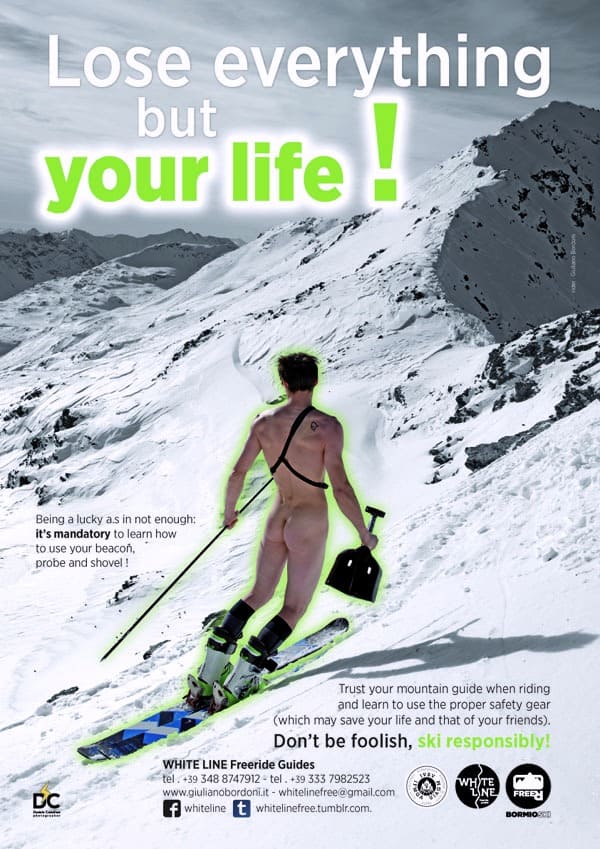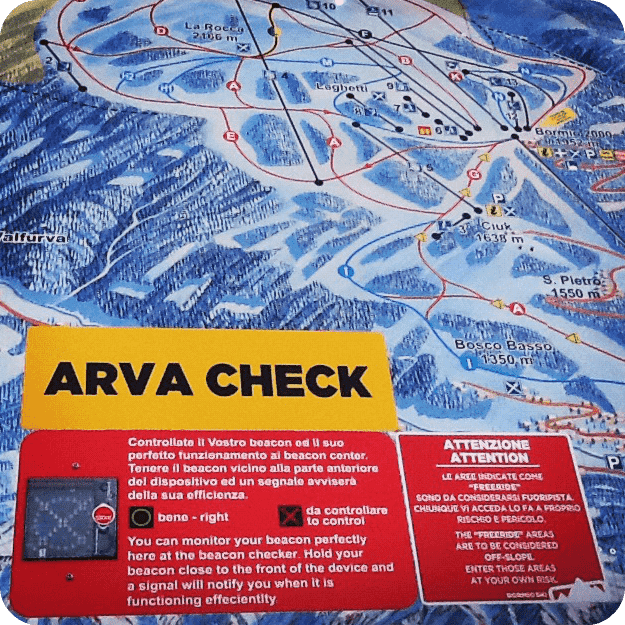Attention! The freeride areas are to be considered off-slope. Enter those areas at your own risk. Follow these simple rules of conduct to enter the freeride zones with more awareness and safety.

- Freeride is an extreme sport. This means it is only addressed to expert skiers/snowboarders, adequately geared and prepared for self-rescue on avalanche.
- If you don’t know the two freeride zones we advise you to go with a mountain guide (tel. +39 348 8747912) or a ski instructor (tel. +39 0342/902183).
- Before you enter the off-piste area always check the avalanche bulletin which you will find on our website or on the maps situated at the starting point and arrival of the cableway Bormio-Bormio 2000. Remember that already with a level 3-considerable the risk of avalanche is possible and especially on drop off. Be careful and move with caution even when the danger level is 1 or 2. Travel strongly not recommended when the level is 4.
- Mandatory gear: freeride skis or snowboard, ARTVA, backpack, drill and shovel. Helmet is well-recommended! A very snowy area is only apparently safe. It can hide a lot of hazardous like hidden rocks or trees. The ARTVA has to be worn with its case close to the body or in a pocket perfectly zipped up. Do not forget to do an ARTVA check in Bormio 2000 and be always well-trained with the use of ARTVA, drill and shovel.
- It is mandatory to re-enter the slopes only from the given trail as indicated on the maps. The freerider can’t ever re-enter the slopes out of the given trail.
- The person who enters the two freeride zones must take up his/her responsabilities which can derive from the pratice of this sport and discharge Società Impianti Bormio from any kind of responsability civil or criminal, as a consequence of injuries or illnesses caused to himself/herself or to a third party within the freeride area.
Avalanche danger scale
| DANGER LEVEL | LIKELIHOOD OF AVALANCHES, SIZE AND DISTRIBUTION | TRAVEL ADVICE |
| - 1 –
LOW |
Natural and human-triggered avalanches unlikely. Small avalanches in isolated areas or extreme terrain. | Generally safe avalanche conditions. Watch for unstable snow on isolated terrain features. |
| - 2 –
MODERATE |
Natural avalanches unlikely; human-triggered avalanches possible. Small avalanches in specific areas; or large avalanches in isolated areas. | Heightened avalanche conditions on specific terrain features. Evaluate snow and terrain carefully; identify features of concern. |
| - 3 –
CONSIDERABLE |
Natural avalanches possible; human-triggered avalanches likely. Small avalanches in many areas; or large avalanches in specific areas; or very large avalanches in isolated areas. | Dangerous avalanche conditions. Careful snowpack evaluation, cautious route-finding and conservative decision-making essential. |
| - 4 –
HIGH |
Natural avalanches likely; human-triggered avalanches very likely. Large avalanches in many areas; or very large avalanches in specific areas. | Very dangerous avalanche conditions. Travel in avalanche terrain not recommended. |
| - 5 –
EXTREME |
Natural and human-triggered avalanches certain. Large to very large avalanches in many areas. | Avoid all avalanche terrain. |
ARTVA CHECK situated in Bormio 2000 by the top station of the cableway Bormio-Bormio 2000!
 Place your avalanche beacon (or ARTVA) close to the device and a signal will confirm the correct functioning of the tool.
Place your avalanche beacon (or ARTVA) close to the device and a signal will confirm the correct functioning of the tool.
©Bormio Ski Press
